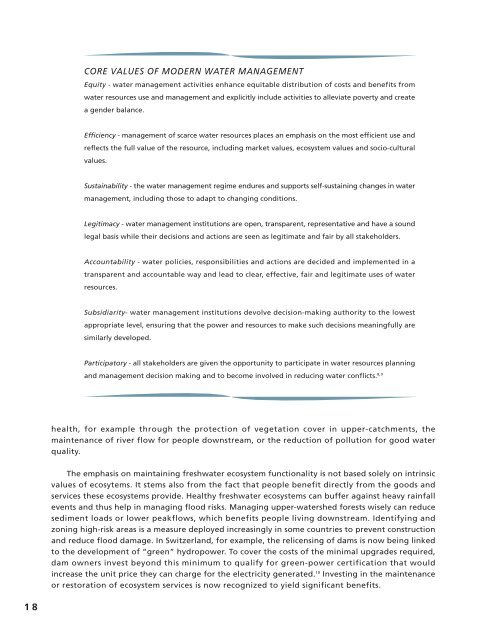Adaptation of water resources management to climate change
Adaptation of water resources management to climate change
Adaptation of water resources management to climate change
Create successful ePaper yourself
Turn your PDF publications into a flip-book with our unique Google optimized e-Paper software.
CORE VALUES OF MODERN WATER MANAGEMENTEquity - <strong>water</strong> <strong>management</strong> activities enhance equitable distribution <strong>of</strong> costs and benefits from<strong>water</strong> <strong>resources</strong> use and <strong>management</strong> and explicitly include activities <strong>to</strong> alleviate poverty and createa gender balance.Efficiency - <strong>management</strong> <strong>of</strong> scarce <strong>water</strong> <strong>resources</strong> places an emphasis on the most efficient use andreflects the full value <strong>of</strong> the resource, including market values, ecosystem values and socio-culturalvalues.Sustainability - the <strong>water</strong> <strong>management</strong> regime endures and supports self-sustaining <strong>change</strong>s in <strong>water</strong><strong>management</strong>, including those <strong>to</strong> adapt <strong>to</strong> changing conditions.Legitimacy - <strong>water</strong> <strong>management</strong> institutions are open, transparent, representative and have a soundlegal basis while their decisions and actions are seen as legitimate and fair by all stakeholders.Accountability - <strong>water</strong> policies, responsibilities and actions are decided and implemented in atransparent and accountable way and lead <strong>to</strong> clear, effective, fair and legitimate uses <strong>of</strong> <strong>water</strong><strong>resources</strong>.Subsidiarity- <strong>water</strong> <strong>management</strong> institutions devolve decision-making authority <strong>to</strong> the lowestappropriate level, ensuring that the power and <strong>resources</strong> <strong>to</strong> make such decisions meaningfully aresimilarly developed.Participa<strong>to</strong>ry - all stakeholders are given the opportunity <strong>to</strong> participate in <strong>water</strong> <strong>resources</strong> planningand <strong>management</strong> decision making and <strong>to</strong> become involved in reducing <strong>water</strong> conflicts. 8,9health, for example through the protection <strong>of</strong> vegetation cover in upper-catchments, themaintenance <strong>of</strong> river flow for people downstream, or the reduction <strong>of</strong> pollution for good <strong>water</strong>quality.The emphasis on maintaining fresh<strong>water</strong> ecosystem functionality is not based solely on intrinsicvalues <strong>of</strong> ecosytems. It stems also from the fact that people benefit directly from the goods andservices these ecosystems provide. Healthy fresh<strong>water</strong> ecosystems can buffer against heavy rainfallevents and thus help in managing flood risks. Managing upper-<strong>water</strong>shed forests wisely can reducesediment loads or lower peakflows, which benefits people living downstream. Identifying andzoning high-risk areas is a measure deployed increasingly in some countries <strong>to</strong> prevent constructionand reduce flood damage. In Switzerland, for example, the relicensing <strong>of</strong> dams is now being linked<strong>to</strong> the development <strong>of</strong> “green” hydropower. To cover the costs <strong>of</strong> the minimal upgrades required,dam owners invest beyond this minimum <strong>to</strong> qualify for green-power certification that wouldincrease the unit price they can charge for the electricity generated. 10 Investing in the maintenanceor res<strong>to</strong>ration <strong>of</strong> ecosystem services is now recognized <strong>to</strong> yield significant benefits.18











![View full document [PDF 988.55 KB] - PreventionWeb](https://img.yumpu.com/47733942/1/184x260/view-full-document-pdf-98855-kb-preventionweb.jpg?quality=85)
![View full document (in French) [PDF 4.96 MB] - PreventionWeb](https://img.yumpu.com/47223870/1/184x260/view-full-document-in-french-pdf-496-mb-preventionweb.jpg?quality=85)


![View full document [PDF 25.02 MB] - PreventionWeb](https://img.yumpu.com/44204570/1/190x234/view-full-document-pdf-2502-mb-preventionweb.jpg?quality=85)
